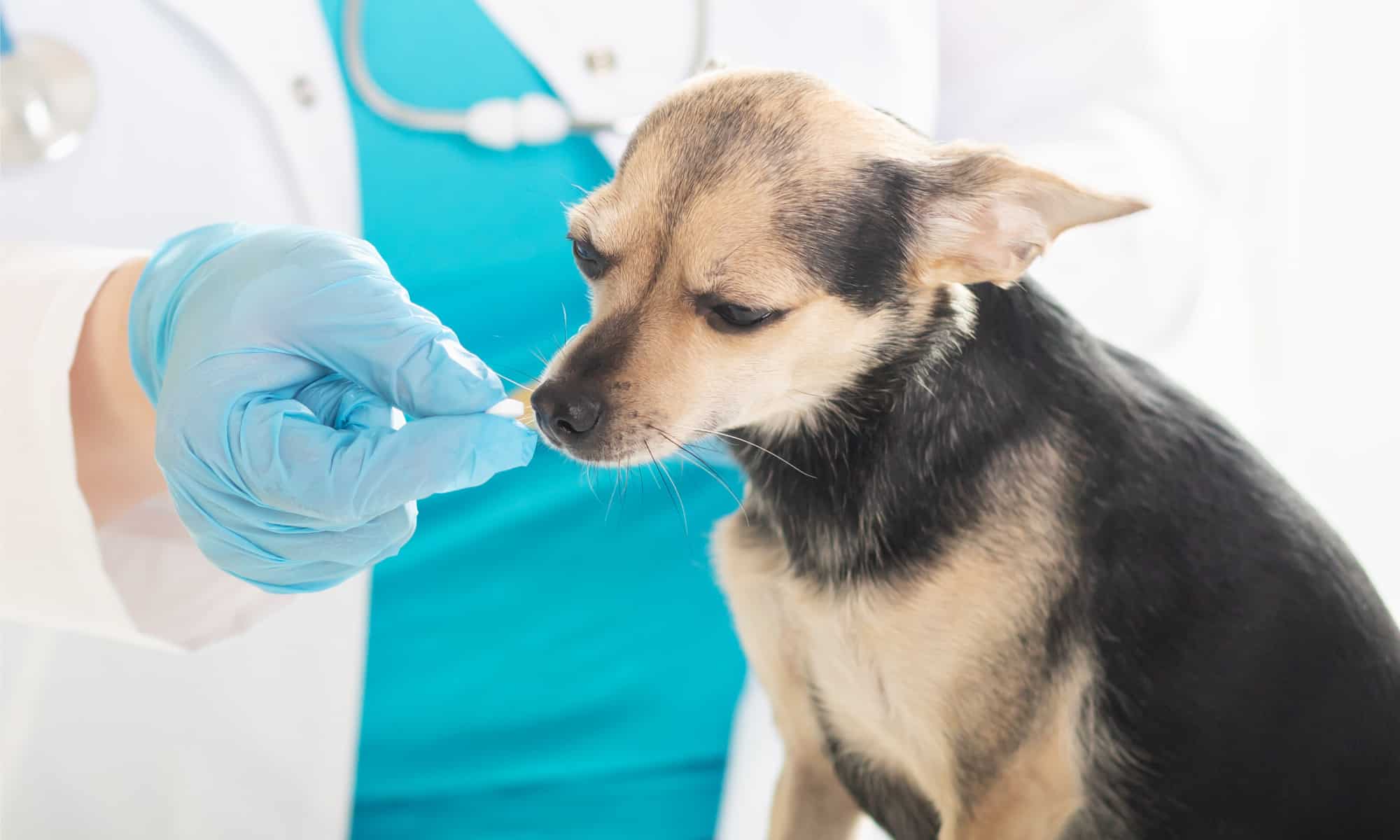Any dog owner prescribed Amoxicillin will most likely wonder how much Amoxicillin to give your dog. You won’t want to mix up the dose, as this antibiotic could have side effects. With your pup already likely in pain, it’s good to know the correct dosage to give them so they can get back on their paws.
Below, we’ll explain everything you need to know about administering Amoxicillin to your dog. This includes the drug’s benefits, risks, dosages, and administration.
What is Amoxicillin?
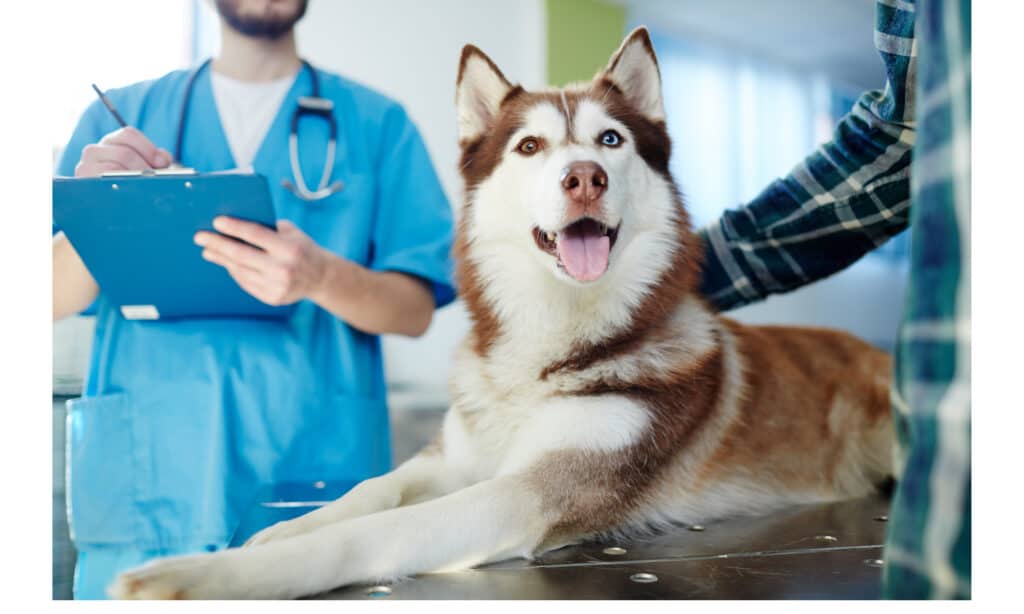
Dogs have often been prescribed amoxicillin at the vet, but exactly how much amoxicillin should you give your dog? Read on to learn.
©Pressmaster/Shutterstock.com
Amoxicillin is a fast-acting antibiotic designed to be a broad-spectrum treatment for bacterial infections. This means it can successfully treat multiple infections in your dog’s body by attacking infections.
Amoxicillin belongs to the penicillin group, which is known to stop the growth of harmful bacteria and prevent infections from spreading. It works by disrupting the growth and reproduction of bacterial cells, leading to the infection being cured. However, Penicillin is only effective at treating certain bacterial infections.
Currently, Amoxicillin is the most commonly prescribed antibiotic for infections. It’s available in various forms, but a pill or capsule is the most common form for dogs. To get Amoxicillin, one must bring their dog into the vet’s office for an evaluation. If the vet decides that the dog needs medication, it will be prescribed to them.
It’s also worth noting you should never use human-prescribed Amoxicillin with your dog. While tempting, the capsules and ingredients might not be dog-friendly. Additionally, you would need to get the right dose, which a certified veterinarian can only calculate.
What Does Amoxicillin Cure in Dogs?
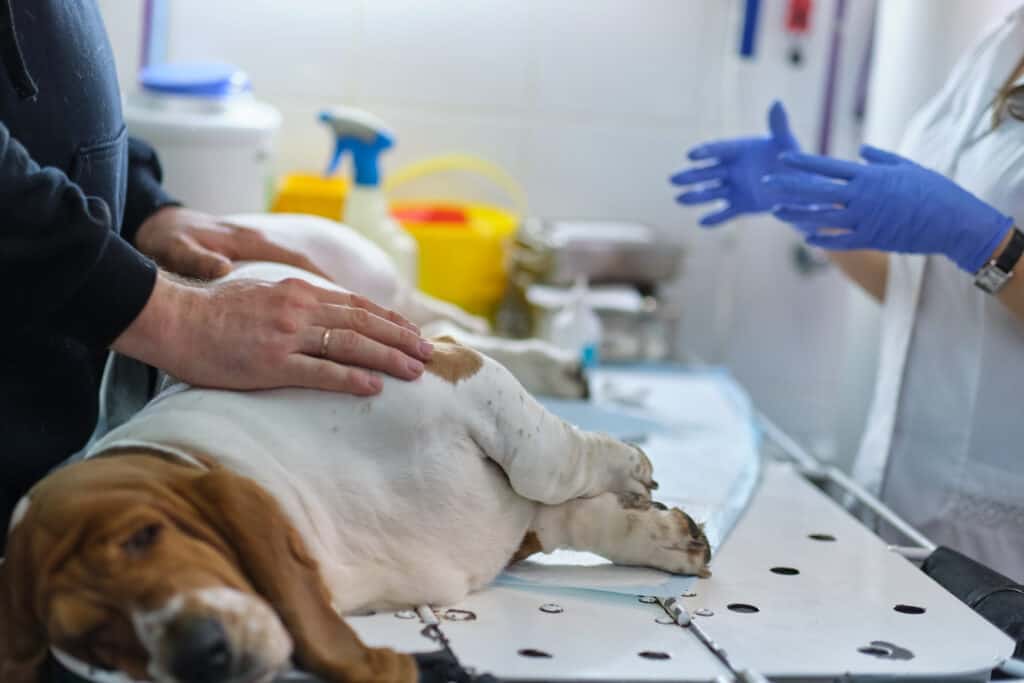
Amoxicillin is used for various conditions in dogs, including skin infections.
©Yavdat/Shutterstock.com
Amoxicillin is an effective treatment cure for a wide range of bacterial infections. However, it may not be effective for all infections. Luckily, a vet can determine if your dog’s symptoms are treatable via Amoxicillin or another antibiotic.
Bacterial infections can cause different issues in the body. Depending on the strain of bacteria your dog has contracted, Amoxicillin will be used as a treatment option. Below are some common infections that Amoxicillin can cure.
Skin Infections
Skin infections can be caused by bacteria and cause three types of infections in dogs. This includes pyoderma, hot spots, and skin abscesses. A dog can also contract a skin infection through another dog’s bite. This means a bite wound can spread bacteria from another dog’s mouth or through skin exposure.
Respiratory Infection
Respiratory infections cause issues with the lungs. Mainly, bacteria cause issues in the upper respiratory tract of a dog. Common diagnoses that Amoxicillin can cure include bronchitis, pneumonia, and kennel cough.
Urinary Tract Infection
A urinary tract infection is a bacterial infection that takes over the kidneys, bladder, ureters, and urethra. Dogs can contract a UTI by exposure to E. coli, Proteus, and Staphylococcus. Generally, a good diet can prevent a UTI. However, if contracted, antibiotics can be prescribed.
Ear Infections
Despite cleaning your dog’s ears, they may develop an infection inside their ear. Ear infections are common in dogs, but not all are treatable using Amoxcillin. The two that are treatable are Staphylococcus and Streptococcus.
Dental Infections
While dental infections are less common, they can still be deadly to dogs if left untreated. Dental infections include similar diseases to human dental health. Some infections include periodontal disease, gingivitis, and tooth abscesses.
When to Contact Your Vet
If your dog is starting to show symptoms of any of the following bacterial infections, you must get your dog to the vet. Infections such as these can end up causing life-threatening damage if not treated in the earlier stages.
Exactly How Much Amoxicillin to Give Your Dog

Vets often base a dog’s amoxicillin dosage on weight.
©megaflopp/Shutterstock.com
In most cases, your vet will evaluate your dog’s condition, and based on the results, they will prescribe a dose. In general, this is exactly how much Amoxicillin to give your dog:
| Dog’s Weight (lbs) | Daily Dosage (mg) |
|---|---|
| 5-10 | 50-100 |
| 10-25 | 100-250 |
| 25-50 | 250-500 |
| 50-100 | 500-1000 |
Amoxicillin is prescribed based on a dog’s body weight and diagnosis and is taken for 10 to 14 days. The antibiotic will generally have a ratio of 5 to 10 mg for every pound of weight. For example, a 10-pound dog will need anywhere from 50 to 100 mg. On the other hand, a large breed that weighs 60 pounds will require up to 300 to 600 mg.
However, always follow the instructions if your vet provides a different dosage. Antibiotics must be taken at a select dose for a minimum of days to eliminate the infection. Skipping a dose or changing the amount can result in the infection returning.
Even worse, your dog can also build up a tolerance called antibiotic resistance. This will make the medicine less effective over time, which can result in the illness going untreated or worse.
How to Administer Amoxicillin to a Dog

Your vet will give you the medication in a tablet, capsule, or liquid.
©JOKE_PHATRAPONG/Shutterstock.com
How you give your dog, Amoxicillin will depend on what form it was given to you. On average, Amoxicillin is prescribed in a tablet, capsule, or liquid.
Dogs are notorious for being able to sniff out even the slightest differences in food. So, you’re going to have to hide the medicine well. Otherwise, your dog may not end up taking medicine.
Here are a few ideas on administering Amoxicillin to your dog.
Pill Pocket
Vet offices or pet stores will have pill pockets made of dog treats. You can easily slide a pill or tablet inside of it, which works as the perfect hiding place for the medicine. In most cases, a dog will gladly eat up the treat, thinking that that’s all they are getting.
Hide in Food
Another method is to hide the medicine in food. Whether you get liquid or a capsule, you can hide the medicine inside their favorite food. For example, if you have peanut butter or apple sauce, you can mix the capsule’s insides into it and give it to your dog. On the other hand, this also works for hiding liquids in broths.
Back of the Mouth
Some dogs get good at spitting out or hiding the medicine. So, you may have to place the capsule into the back of their throat until they swallow. Dogs who know what’s coming when it’s time to administer the drug are the most likely to benefit from this method.
What to Do If Your Dog Spits Its Medicine Out
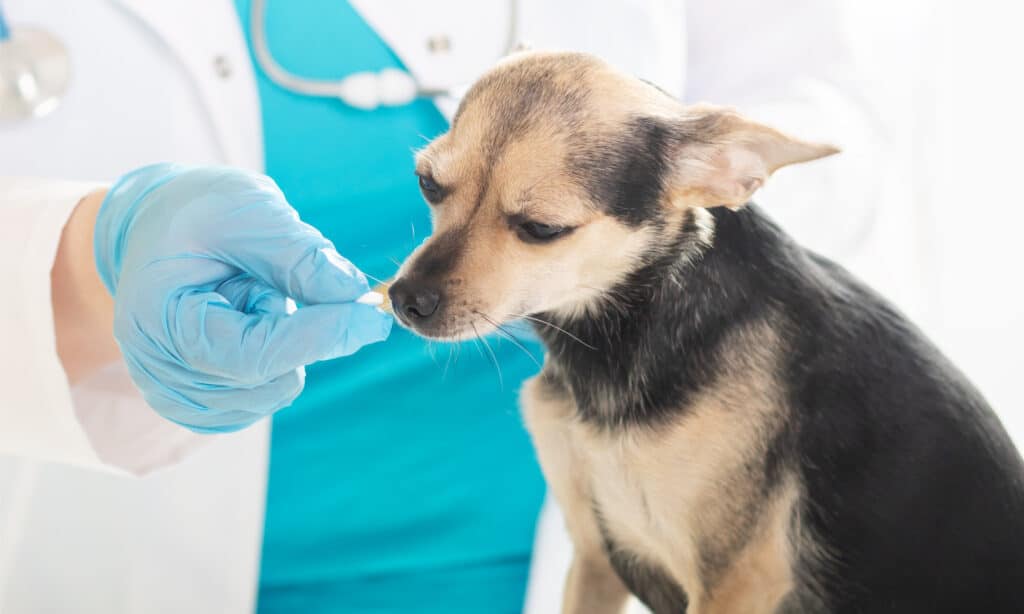
Your dog needs to take every dose of their medicine as prescribed.
©iStock.com/Yana Tikhonova
Dogs don’t always take well to medicine, as they aren’t tasty, nor do they understand the benefits. If your dog spits out its medicine or misses a dose, you need to call your veterinarian immediately.
Missing a dose of antibiotics doesn’t seem like a big deal, but it is. Antibiotics work to counteract the multiplying bacterial infection inside your dog. If a dose is missed, the cells will continue multiplying and have time to build up resistance. This can cause the infection to grow back or even become more severe.
You must call your veterinarian if your dog misses a dose or finds that they’ve spat or vomited the medicine out. In most cases, a veterinarian will recommend that you readminister the dose to ensure the dog’s infection doesn’t further. However, you must follow the vet’s orders, as overdosing on Amoxicillin can have adverse side effects.
What Are the Side Effects of Amoxicillin?

Your dog may have specific side effects after it digests amoxicillin.
©Prystai/Shutterstock.com
When Amoxicillin is digested, it kills all bacteria in the body, including natural bacteria in the gut. Due to this, a dog may have gastrointestinal tract irritation. This can include the following:
- Diarrhea
- Nausea
- Abdominal pain
- Skin irritation
- Lack of appetite
You will want to contact your veterinarian if you’ve administered Amoxicillin to your dog and they show a few specific symptoms. Facial swelling, hives, rashes, and difficulty breathing are all signs of an allergic reaction to the drug. If your dog starts to display these symptoms, you must take them to the vet immediately.
How Do You Soothe Gastrointestinal Tract Irritation?
A veterinarian will prescribe probiotics to help make up for the lack of natural gut flora. By introducing good bacteria back into the gut, some symptoms of irritation can be relieved. However, probiotics alone will not get rid of all symptoms.
Can All Dogs Take Amoxicillin?
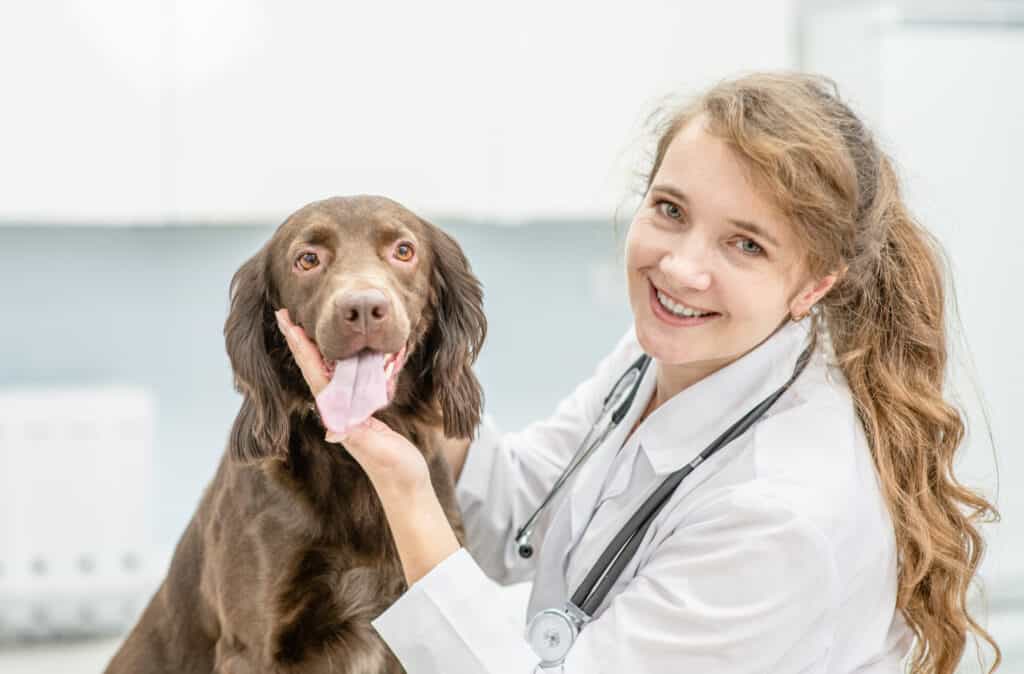
Some dogs might not be able to take the medication.
©Ermolaev Alexander/Shutterstock.com
Similarly to humans, some dogs may not be able to take Amoxicillin as a treatment option due to underlying conditions. Some of these include
- Hypersensitivity
- Allergies (Penicillin, cephalosporin, beta-lactam)
- Other prescriptions incompatible with Amoxicillin
- Pregnant or lactating
Besides this, Amoxicillin can also be ineffective for dogs with certain conditions. This includes
- Shock
- Blood infections
- Systemic diseases
Can Too Much Amoxicillin Hurt A Dog?
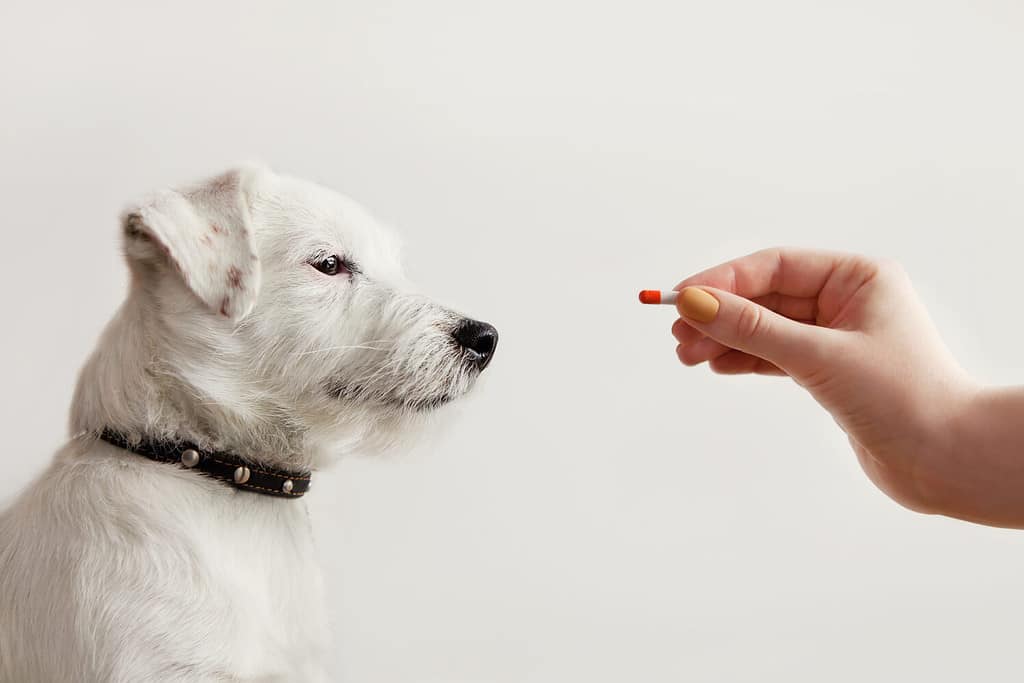
This penicillin-type antibiotic may be toxic to the nervous system and too much can lead to kidney damage.
©Liudmyla Guniavaia/Shutterstock.com
As with everything dogs may consume, too much of anything is not good for your pet. However, when it comes to medicine like amoxicillin, ingesting extremely high doses can have an adverse effect. This penicillin-type antibiotic may be toxic to the nervous system and it might not only cause damage and inflammation to the kidneys but may bring about a formation of crystals in the urine which can lead to future kidney failure.
Some of the signs to be on the lookout for should your dog ingest too much of this medicine are diarrhea, vomiting, difficulting breathing, and panting. They should be taken to your vet immediately where they will be able to monitor them after administering treatments like activated charcoal or intravenous fluids.
The Bottom Line
Contacting a veterinarian should always be your first line of defense for keeping your dog healthy. While this article may help you figure out dosing, it does not make up for a visit to the vet. Dosage can differ for each pup, and you don’t want to get the dose wrong due to the aversive effects.
If you’ve forgotten the dosing for your dog’s medicine, you can either call the office or look up their prescription online. These ensure your dog won’t have any ill effects from taking the wrong dose.
Additionally, giving your dog extra antibiotics does not increase its chances of curing the infection. Administering a higher dose can end up causing antibiotic resistance which makes the medicine less effective. That being said, we hope that this has helped you better understand exactly how much Amoxicillin to give your dog.
Ready to discover the top 10 cutest dog breeds in the entire world?
How about the fastest dogs, the largest dogs and those that are -- quite frankly -- just the kindest dogs on the planet? Each day, AZ Animals sends out lists just like this to our thousands of email subscribers. And the best part? It's FREE. Join today by entering your email below.
Thank you for reading! Have some feedback for us? Contact the AZ Animals editorial team.

